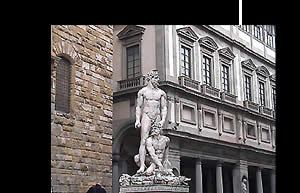|
Italian Museums
Italy’s museum heritage is the largest
in the world with something in the region of 1,500 museums;
this is due to the fact that Italy itself possesses almost
half of the world’s entire artistic heritage. Italy is
indeed a unique phenomenon in world terms, not only for its
vast munbers of works, but also for a sort of uninterrupted
continuity that links those works, as one style era follows
on smoothly to the next, from the Stone Age onwards, with
no breaks or gaps, as if every artistic invention and art
form had been tried out to begin with in Italy. And what’s
more, beneath the ground are buried works as yet unrecovered,
and endless amounts of riches lie beneath the sea. Italian
art has made its way into Italy’s finest and most beautiful
museums whose collections include some of the world’s
most prestigious artworks e.g. the Pinacoteca of Brera,
the Uffizi Gallery in Florence and the Vatican Museums
in Rome.
Italy’s museums are important not only
for their collections’ fullness, the calibre of the works
on show and the high quality of scientific research within
the field but also because they are socially and didactically
accessible to a non-specialist public. In fact over the past
thirty years museums in Italy have become key centres of social
and educational service: the National Gallery of Modern
Art in Rome alone receives an average of 4,000 visitors
per month. In Italian museums one can find guided visits,
long opening hours, welcome centres and sales points. Visitors
in general are highly appreciative of the way works are arranged
and also of the lighting. Theme exhibitions relating to collections
can often be found inside museums as well as special talks
and meetings.
As every museum is a place for cultural exchange
in that it houses objects and arranges them specifically to
provide the visitor with a key to interpretation, in recent
years the Italian museum is actively intervening with a whole
range of expedients and initiatives whose purpose is to prepare
the public for looking at works of art in a different light
and considering art in new ways rather than by traditional
standards. This is achieved through initiatives such as theme
exhibitions, single artist shows, architectural walks and
art appreciation sessions.
home
|
|











